| Year | Population |
|---|---|
| 1970 | 4,044 |
| 1980 | 4,262 |
| 1990 | 3,963 |
| 2000 | 3,447 |
| 2010 | 3,123 |
| Geographic Data | |
|---|---|
| N. Latitude | 45:08:01 |
| W. Longitude | 67:12:83 |
| Maine House | District 140 |
| Maine Senate | District 6 |
| Congress | District 2 |
| Area sq. mi. | (total) 40.0 |
| Area sq. mi. | (land) 34.0 |
| Population/sq.mi. | (land) 91.9 |
County: Washington
Total=land+water; Land=land only |
|
[KAL-us] in Washington County was incorporated on June 16, 1809 from Plantation Number 5 PS. On November 18, 1850 it became a city. This 1913 postcard is of Main Street.
The area was briefly settled in 1604 when a French expedition arrived on St. Croix Island in the St. Criox River. The brutal winter of 1604-05 hastened the end of the settlement, which was abandoned in August 1605.
Over 150 years later Daniel Hill, from the Machias area, arrived and built the first house and, with others, the first sawmill. According to the Calais Comprehensive Plan,
In the 1820s and 1830s, Calais was the commercial center of the St. Croix Valley. The first ship was built in 1803 and over the next fifty years 250 more vessels were constructed in the busy Calais shipyards. By the end of the 1840s Calais grew to become the second leading port in Maine, ranking only behind Bangor on the Penobscot River.
In 1881, the first international telephone conversation took place from Calais to St. Stephen, New Brunswick.
At Red Beach in the southeast of the town, a local Granite Cutters Union was formed in 1897 .
[NOTE: in this video the Job Holmes House is incorrectly identified as the Holmes Cottage.]
Today downtown features late 19th century brick structures, modern state and federal buildings, and a visitor center.
Named for the French port by the same name, in honor of that country’s support during the American Revolution, Calais has traditionally had warm relations with its sister community, St. Stephen, on the Canadian side.
By the 1970’s, the St. Croix, and other Maine rivers, were polluted by the discharges from paper mills.
The photo at left below depicts, foam, a sign of pollution, as it floats on the St. Croix river at Calais, down river from the Georgia Pacific paper mill in May of 1973.*
Since that time the rivers have been improved as a result of court decisions and action by the U.S. Congress.

St. Croix River North of Calais, where the fishing is good for humans and the large eagle population (2007)
Calais was one of two mythical sons of Boreas, the Greek god of the North Wind. Calais and his brother followed Jason on his quest for the Golden Fleece, protecting him from the bird-women Harpies. (click photo at right)
The city is the birthplace of 19th century U.S. Representative, and mayor of the city, Frederick A. Pike (1816-1886). James Shepherd Pike, born in Calais, was a journalist and from 1850-1860 he was the chief Washington correspondent and associate editor of the New York Tribune. 19th century U.S. Representative Thomas Fuller practiced law in the city.
Calais is home to the Washington County Community College.
For the past thirty years, Calais has been a community in decline as population has diminished. The National Register list below, however, indicates its rich historical roots.
*U.S. EPA photo, National Archives # NWDNS-412-DA-7881.
**Photo by Timothy Montgomery in December 2001, from a riverside park in Calais. (Creative Commons license)
Congressional Medal of Honor Recipient
HORATIO N. YOUNG
Form of Government: Council-Mayor-Manager.
More Videos!
Additional resources
Bacon, George F. Calais, Eastport and vicinity, their representative business men, and points of interest,. . . Newark, N. J. Glenwood Publishing Company. 1892.
Boone, Mary Priscilla. Chronicles of Calais and Vicinity. Part I – 1604-1820. 1947. [University of Maine, Raymond H. Fogler Library, Special Collections]
Calais, Maine: The Center of Way-Down-East. Calais, Me. Calais Chamber of Commerce. 1929? [Maine State Library; University of Maine, Raymond H. Fogler Library, Special Collections]
Knowlton, I. C. Annals of Calais, Maine and St. Stephen, New Brunswick [microform]: including the village of Milltown, Me., and the present town of Milltown, N.B. Calais, Me. 1875. (J.A. Sears) [University of Maine, Raymond H. Fogler Library, Microforms]
Maine. Historic Preservation Commission. Augusta, Me. Text and photo from National Register of Historic Places.
National Park Service. “Saint Croix Island, History & Culture.” http://www.nps.gov/sacr/learn/historyculture/index.htm (accessed March 4, 2015)
Talbot, George Foster. “James Shepherd Pike; a Biographical Sketch.” Read before the Maine Historical Society, December 22, 1885. Portland, S. Berry. 1885. [Bangor Public Library].
National Register of Historic Places – Listings
Calais Free Library
[Union Street, 0.05 miles northwest of the junction with US Route 1 (see video above)] The 1893 Calais Free Library is a Richardsonian Romanesque brick building with quarry faced brownstone trim and a granite foundation from designs by the Boston architect Arthur H. Vinal. The building is located at one end of the downtown commercial district in Calais.
Calais enjoyed public or semi-public library services for several decades before the Free Library. In the 1830s, members of the Calais Young Men’s Society began pledging to regularly buy books for a library, sometimes on a monthly basis. A paid public library was destroyed in the “great fire” of August, 1870. The remnants moved to a room in the St. Croix Hall Building, and by 1874 contained 25,000 volumes available to the public for a small fee.
Calais Free Library came from a gift from one of the city’s notable citizens, James Shepherd Pike. Pike left his home to the city of Calais for the express purpose of housing the “Calais Free Library and Reading Room.” He was successful businessman in the lumber industry. After moving to Washington, D.C., Pike was appointed Minister to the Netherlands in 1861 by President Lincoln. The library holds his forty two notebook diaries and letters from Salmon P. Chase, Horace E. Greeley, Charles A. Dana, and William Pitt Fessenden, among other figures of the Civil War period.
Calais Observatory
The Calais Observatory is a site on which was formerly located as a United States Coast Survey astronomical observatory. The observatory is located in the far eastern town of Calais on an outcrop dome in a residential neighborhood. Marking the site of the observatory are a stone pillar and stone base, both used to support astronomical instruments, as well as two drill holes and a pair of stone pads chiseled out of the granite. Erected first in 1857, and utilized again in 1866 and 1895, the observations and measurements recorded at the site made nationally significant contributions to the advancement of a broad range of geophysical scientific fields. Here in December 1866, astronomical observations (star meridian passages) were taken that finalized the longitudinal measurements between America and the Greenwich Meridian, or Prime Meridian, in England, an important step in determining the precise shape of the earth and creating a universal geophysical framework for measuring time and space. In addition, this observatory is unique as the only remaining observatory from the Transatlantic Telegraphic Longitude Campaign of 1866 that still has in place the stones upon which the scientific instruments were mounted. As such, the Calais Observatory was listed in the National Register of Historic Places at the national level of significance for its role in contributing to geophysical scientific advances.
Calais Historic District
[Church, Main and North Streets] The Historic District exhibits commercial and governmental architecture of the mid to late 19th century. The cohesive block has not undergone any major exterior changes nor been encroached upon by modern intrusions. The buildings in the district were built at a time when Calais was a thriving shipbuilding and lumber port, and are an excellent tribute to that era.
In August 1870 a major fire destroyed much of the downtown area. It began to the east of the Main Street Historic District block behind the Old Post Office. The fire spread down Main Street and consumed the wooden frame buildings up to the location of the present Ross Store. Construction was resumed immediately following, the fire and all new building was done in brick.***
Photos above and below are of buildings in or near the Historic District 2013, including the Romanesque Revival City Building and the Italianate Old Fire House.
Calais Residential Historic District
[roughly, area along Main Street and Calais Avenue, from Calais Avenue to Swan Street] The Calais Residential Historic District embraces the largest and most intact concentration of the city’s historic non-commercial architecture. Although primarily residential in character, there are several other property types including two designed landscapes, the whole of which serve to illustrate a distinct aspect of the community’s 19th century development. The district illustrates patterns of community planning and development, architecture and landscape architecture.
The Residential Historic District is an irregular L-shaped area of approximately fifteen acres located along a portion of the south side of Main Street and both sides of Calais Avenue. It is primarily residential in character, but does contain a former 19th century hotel building, one church, and a park. There are twenty-four properties that contribute to its historic character.
The district is comprised of a group of 19th century buildings, including well preserved examples of Federal, Greek Revival, Italianate, and Queen Anne style buildings. With the exception of two brick structures, these buildings are of frame construction, typically with weatherboard sheathing. The oldest house in the district is the Federal period Holmes Cottage, a one-and-a-half story, cape featuring a central chimney. A second Federal house was built of brick about 1830.
Construction in the historic district during the post-Civil War period was limited, being confined primarily to previously undeveloped lots at the eastern end of Main Street. Two of the most notable changes resulted from the relocation of the Congregational Church in 1872 (destroyed by fire in 1992) with the subsequent extension of Calais Avenue, and the creation of Memorial Park about 1891. The handful of homes built in this period show modest Queen Anne style characteristics including asymmetrical silhouettes, a variety of sheathing materials, bay windows, and porches.
Gilmore House
[316 Main Street] The Gilmore House is the finest of an unusual row of three intricately detailed Gothic Revival houses evidently built at the same time in the early 1850’s. The sophisticated design is unusual considering that Calais was basically a frontier town just emerging as a commercial and industrial center. The earliest known, probably original, owner was Alexander Gilmore, who was born in Belfast, Ireland in 1821 and arrived in Calais around 1839. A prosperous merchant, he probably built the house in the early 1850s for his first wife, who died in 1854.
The steep pitched double gable arrangement with recessed tripartite window between on the southwest facade is very similar to the 1849 Henry Boody House in Brunswick, designed by Gervaise Wheeler; and two other Gothic houses in Portland’s National Register places: The Gothic House and the Sparrow House.] *** [Kirk F. Mohney photo]
Hamilton, Thomas, House
[78 South Street] “This extremely pretentious (for its location) and unusually designed Italianate house may reflect in its unique qualities the character flaws of its first owner. Nevertheless, it stands as a landmark in Calais, known over the years as “Hamilton’s Folly”. Thomas L. Hamilton was apparently a businessman who in his early career experienced certain modest success”, evidently his prosperity went to his head. He began to dress ostentatiously, bought expensive horses and carriages and built his fine house on South Street as a symbol of his position, as he imagined it, in the community. Registry records show that a series of mortgages were soon engaged in and in a very short span of time Mr. Hamilton had lost his house, his horses and all else. It is recorded that he died in the poorhouse.
“At one time the house was owned by the Orthodox Congregational Church of St. Stephen, New Brunswick, across the river. In 1916 and 1923 it was owned by two different banks indicating, perhaps, other unlucky owners. More recently it became the residence of Clarence B. Beckett, mayor of Calais in 1935 and later a member of the Governor’s Council. During this period at least two Maine Governors were overnight guests.”*** [Frank A. Beard photo]
Hinckley Hill Historic District
[roughly, 305–326 Main Street] The Hinckley Hill Historic District embraces a small, but architecturally and historically important collection of residential buildings, illustrating a distinct aspect of the community’s 19th century development. The rapid development of Calais in the early and 19th century resulted in the construction of a large number of Federal, Greek Revival, Italianate, and to a lesser degree, Gothic Revival residences. During the late 1860s, the immediate post-war period was one that saw growth in the residential building stock, but also an emerging concern about the city’s future. Among the major houses built in Calais at this time was a “palatial mansion” of nineteen rooms in the “Grecian style” designed by the local builder/ architect Matthew Baker. Further construction took place after a fire in August, 1870 destroyed much of the commercial district and several nearby dwellings.
The photo above apparently has been damaged, as were others in this nomination file.]
The economic doldrums in which Calais found itself later in the post-war period, began to change by the end of the 1880s. The 1910 an Industrial Journal article pointed to the establishment of a more diversified industrial base as the reason for the reversal. The major development was the founding in 1887 of the St. Croix Shoe Factory which, by 1890, employed some 250 persons. Further opportunity for employment would be provided by a second shoe factory and the newly built St. Croix Cotton Mill in St. Stephen. By spring of 1893, the Industrial Journal reported: The large number of buildings under construction in Calais indicate prosperous times for the Frontier City. A dozen new dwellings are going up on the west side of Lincoln Street, in Highland Park, and many tenements are being called for to accommodate the families that the new granite industry will bring there. Finally, in the late 1920s the Chamber of Commerce called attention to the fact that “Calais has always been and is a city of homes.”
The Hinckley Hill neighborhood in the early 20th century certainly verified these descriptions. They are evident in the scale, quality, and condition of the buildings in the district. A gambrel roofed Colonial Revival house (6), was added in 1927 and modifications were made to several earlier houses. In addition, a modest house (5) was built about 1950 and in 1994 another new dwelling (7) was raised on the site of a c. 1875 Italianate house which had burned the year before. These changes underscored the continued desirability of the neighborhood. However, in the second half of the century commercial development to the west of the district has substantially altered the integrity of the entire Main Street corridor, isolating the district from the once contiguous group of homes that extended to the Calais Residential Historic District further west.*
Holmes Cottage
[241 Main Street]
The Holmes Cottage is the oldest known dwelling in Calais and later became the residence and medical office of Dr. Job Holmes, a leading physician during the town’s formative period of development. Local tradition claims that the Holmes Cottage was built prior to 1805. However, the overall form of the cottage and the historical context suggest it was probably built between 1820 and 1830. Sometime after 1836, Dr. Job Holmes occupied it with his family until the 1850s when he built a new house on an adjoining lot. The cottage remained in the Holmes family until 1954 when it was given to the St. Croix Historical Society. [Kirk F. Mohney photo]
Holmes, Dr. Job, House
[247 Main Street (see video above) ] Also known as the Holmested, and home to the St. Croix Historical Society, its location is the same, but the current address is now 527 Maine Street; geo coordinates: N45° 11′ 15.41, W67° 16′ 24.88.]
The 1851 Holmes House is among the most architecturally significant Italianate style dwellings in Calais. It was constructed in for Dr. Job Holmes, a physician who had established his medical practice in the second quarter of the nineteenth century in what was at that time a booming lumber shipping port.
A graduate of Bowdoin College’s Maine Medical School, Holmes married Vesta Hamlin, the sister of Vice President Hannibal Hamlin. Another brother, Dr. Cyrus Hamlin, was a classmate of Holmes at medical school and established his practice in Calais about 1830. Holmes and his wife followed Hamlin to Calais some years thereafter where they initially settled in the Holmes Cottage, built around 1806. Their subsequent prosperity is reflected in the size and detailing of the new house built for them in 1851.***
Jellison, Theodore House
[River Road] This granite structure on the banks of the St. Croix River was built in 1825, probably the second oldest dwelling in Calais. A raised wood veranda was added in 1925. The twin dormers on the east slope of the roof date from the same period.
A large and rare stone house built into the bank of the St. Croix River, it is important because of the excellence of its design, construction and its early history. It was built by Theodore Jellison an owner of granite quarries in the vicinity. He chose a design demonstrating how construction with granite could be achieved. He also built a granite wharf so ships could ground out at low tide, be loaded with granite and floated on the 24 to 28 foot tides. He thought this area would become the center of Calais. Events proved otherwise and the town center grew two miles upstream.*** [Frank A. Beard photo]
McGlashan–Nickerson House
[St. Croix Drive near Pettegrove Point, Red Beach] The c. 1883 McGlashan-Nickerson House is a rambling two story frame dwelling whose long ell extends to a carriage barn. It was built for Scottish immigrant George G. McGlashan, but was acquired soon after by Calais justice Samuel H. Nickerson. The house is one of the two or three most architecturally significant houses in the small village of Red Beach, and the only one that displays such wide use of Italianate style details.
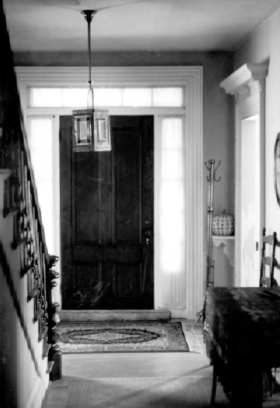 During the 19th century Red Beach was a thriving community whose existence revolved around two industrial enterprises: the Maine Red Granite Company and the Red Beach Plaster Company. Both occupied a group of buildings, now gone, that were concentrated along the banks of Red Beach Cove. Surrounding this industrial center was a village whose housing stock ranged from modest capes and worker houses to the few large residences of the plant managers and owners. McGlashan’s Italianate style house is in this second group along with the nearby Gothic Revival style J. Pettigrove House. McGlashan’s pedimented window and door hoods, typically found on the most elaborate of urban Italianate houses, give it local architectural distinction.
During the 19th century Red Beach was a thriving community whose existence revolved around two industrial enterprises: the Maine Red Granite Company and the Red Beach Plaster Company. Both occupied a group of buildings, now gone, that were concentrated along the banks of Red Beach Cove. Surrounding this industrial center was a village whose housing stock ranged from modest capes and worker houses to the few large residences of the plant managers and owners. McGlashan’s Italianate style house is in this second group along with the nearby Gothic Revival style J. Pettigrove House. McGlashan’s pedimented window and door hoods, typically found on the most elaborate of urban Italianate houses, give it local architectural distinction.
George G. McGlashan came to Red Beach to establish a quarrying operation for red granite. The Maine Red Granite Company was organized in 1876 by a group of ten stockholders. McGlashan was one of the minor stockholders. By 1884 his holdings had increased to 25 shares. By 1888, McGlashan’s shares were held by his estate in Aberdeen, Scotland. In November 1887 McGlashan’s widow sold the property in Red Beach to Samuel H. Nickerson, a justice in Calais. He and his wife occupied the house until their deaths, and it then descended to their daughter Virginia (Nickerson) McMaster, who sold in 1985.* [Kirk F. Mohney photos]
Pettegrove, Joshua, House
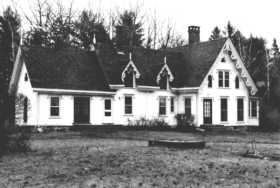 [east side US Route 1, .25 miles north of the junction with Shattuck Road, Red Beach] The c. 1854 Joshua Pettegrove House is an ornate and well preserved Gothic Revival style frame house on a picturesque site overlooking the St. Croix River. The house was long occupied by – if not built for – the Pettegrove family. It is one of about a half-dozen extant Gothic cottages built in the neighboring towns of Calais and Robbinston between the early 1850s and early 1860s. The house changed several times until 1862 it was returned to Pamela Pettegrove.; nonetheless, the Pettegroves appear to have occupied the house throughout the period. Joshua and Pamela Pettegrove had emigrated to the United States from New Brunswick between 1852 and 1854.
[east side US Route 1, .25 miles north of the junction with Shattuck Road, Red Beach] The c. 1854 Joshua Pettegrove House is an ornate and well preserved Gothic Revival style frame house on a picturesque site overlooking the St. Croix River. The house was long occupied by – if not built for – the Pettegrove family. It is one of about a half-dozen extant Gothic cottages built in the neighboring towns of Calais and Robbinston between the early 1850s and early 1860s. The house changed several times until 1862 it was returned to Pamela Pettegrove.; nonetheless, the Pettegroves appear to have occupied the house throughout the period. Joshua and Pamela Pettegrove had emigrated to the United States from New Brunswick between 1852 and 1854.
Joshua Pettegrove was a master mariner by occupation. Pettegrove was one of two or three ship builders in Red Beach in the mid-1850s. After Pamela’s death in the 1860s, Joshua Pettegrove remarried. In 1896 and 1897 Pettegrove’s widow and heirs sold the property to Frederick G. Pettegrove who held it until 1915. It passed through several owners thereafter until it was acquired in 1948 by Charles S. Livingstone. The architectural significance of the Pettegrove house derives from its well developed and preserved Gothic Revival form.* [Kirk F. Mohney photos]
Pike’s Mile Markers
[twelve locations spaced 1 mile apart along East side of US Route 1 between Robbinston and Calais] Pike’s Mile Markers are granite slabs inscribed with the numbers 1-12 and the words “Mile(s) To Calais” along U.S. Route 1 between Robbinston and Calais. They were placed sometime between 1866 and 1882 by James Shepherd Pike (1811-1882), a well-known journalist, diplomat, and politician. He was the brother of legislator and congress member Frederick August Pike.
Pike is said to have methodically measured the distance between his business in Calais and his home in Robbinston. The markers are a distinct, unusual reminder of his presence in Calais and Robbinston. They are the only markers of their type and integrity in Maine.
By the early 1840s Pike had sufficient wealth to spend his winters in Boston, New York, and Washington. He began to express his anti-slavery opinions in the Boston Atlas, Boston Courier, and the Portland Advertiser. In 1850 Horace Greely invited him to submit articles to the New York Tribune. During the mid-1850s, Pike was active in the formation of the Maine Republican Party. He served as Ambassador to the Netherlands, 1861-1866.
In 1866 he bought the “Mansion House” in Robbinston, former residence of General Brewer. While “retired” he kept his journalistic interests, writing for the Tribune and publishing his own works.*** [Brand Livingstone photo]
St. Anne’s Episcopal Church
[Church Street (see video above)] This handsomely conceived and detailed Gothic Revival Church was designed by James Renwick (1818-1895), one of the three or four most noted mid-nineteenth century architects in the United States. It is his only known building designed in Maine. The designs for this asymmetrical, “exuberant, expansive” church were donated by Renwick for reasons not clear. At the same time his major project, the original building of the Smithsonian Institution in Washington, was underway. Renwick designed several important churches in New York City and elsewhere as well as the first unit of the Corcoran Art Gallery. His career climaxed with St. Patrick’s Cathedral on Fifth Avenue begun in 1858 and finally completed in 1887.***
St. Croix Island International Historic Site
[on the international boundary in the St. Croix River] The National Park Service describes the historic site near St.Croix Island on the banks of the St. Croix River in Calais as follows:
Saint Croix Island is the 1604 site of the first French attempt to colonize the territory they called l’Acadie and the location of one of the earliest European settlements in North America. Members of a French expedition led by Pierre Dugua, intending to colonize North America, settled the island in 1604.
Seventy-nine members of the expedition, including Samuel Champlain, passed the severe winter of 1604-1605 on the island. Thirty-five settlers died, apparently of scurvy, and were buried in a small cemetery on Saint Croix Island. In spring 1605 the Passamaquoddy, befriended by the French, returned from their winter sojourn to the shores of Saint Croix Island. They traded game for bread and the health of the remaining settlers improved. Pierre Dugua made the decision to move the colony and founded the settlement of Port Royal, in today’s Nova Scotia.**** [See video above.]
Washburn, George, House
[318 Main Street] This house is one of a group of three distinctive Gothic Revival homes built side by side over a two year period by different owners. No explanation has been found for this grouping of stylistically similar and urbane structures.
George Washburn, like Alexander Gilmore, was evidently a successful local businessman and it appears likely that he, together with his brother Charles, who built the third house (now altered too much to retain historic significance), joined with Gilmore in the purchase of this choice piece of property on what was then the outskirts of Calais high on the bank overlooking the St. Croix River and Canada on the other shore. Whatever the reason, these houses reflect an originality and sophistication unusual for their time and place.*** [Frank A. Beard photo]
Whitlocks Mill Light Station
[south bank of St. Croix River] In 1909 this was the last Light Station built in Maine, a guide to the upper St. Croix River and the harbor at Calais. During the 19th and early 20th century the St. Croix was heavily trafficked serving both the United States and Canadian sides. Beginning in the 1820s Calais, northwest of Whitlocks Mill light, developed into an important lumber shipping terminal. By the early 20th century, the it had many merchants and manufacturers. Despite access to the Washington County Railroad, much commerce was dependent on maritime transportation.
Not until 1892, however, had an aid to navigation been placed at the site: a red lantern on a tree. That was replaced by the light station in 1909. The light has been automated and the ancillary buildings sold.*** [Roger G. Reed photos]
The U.S. Inspection Station—Calais, Ferry Point
[N45° 11′ 26.04″ W67° 16′ 58.26″] Built in 1935-1936,the Station was sited alongside a border highway. Its construction was in direct response to a chain of events including the imposition of head taxes and country quotas on immigration in 1917 and 1921, smuggling arising from the prohibition of alcohol in 1919, and the increase in usage of the automobile and improved roads in the 1920s.
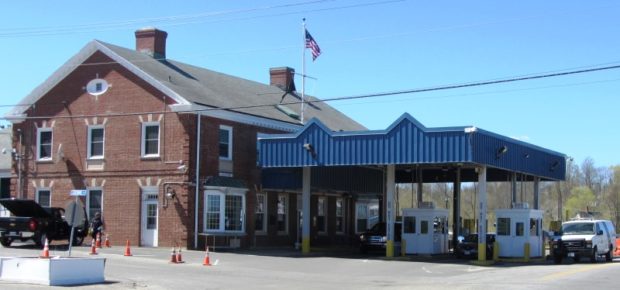
The exterior and interior of the main station and detached garage still convey the historical design, workmanship, and materials of the facility’s original construction. The Colonial Revival design system was employed throughout the facility through a combination of the following: brick or clapboard exterior wall surfaces, symmetrical design, steep gable or pyramidal roofs, multi-light double-hung sash windows, keystones in flat arches, quoins, and Colonial ornamentation.
The two contributing buildings retain integrity despite the noticeable replacement of the porte-cochere♦, and are both a good example of the Colonial Revival style, particularly for its value as a record of the self-image of federal government buildings during the 1930s.***
♦ “a covered entrance large enough for vehicles to pass through”


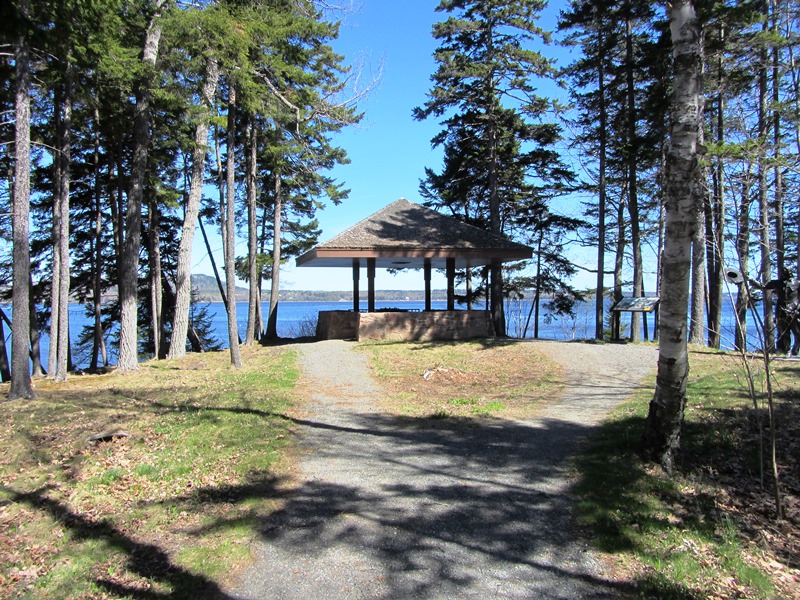


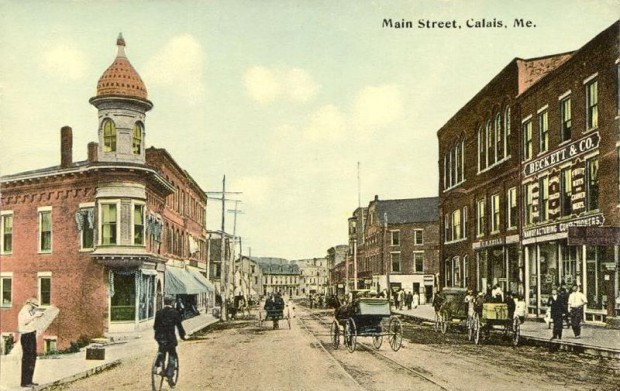
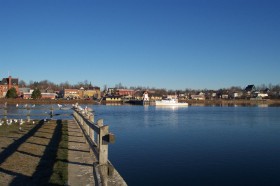
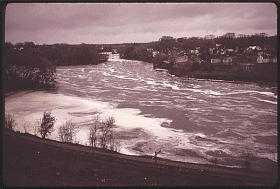


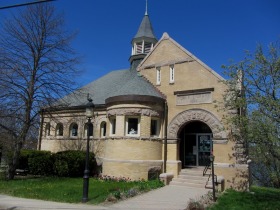

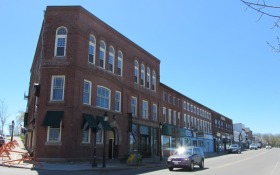
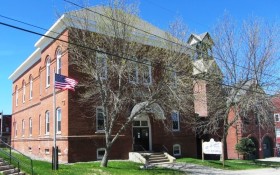

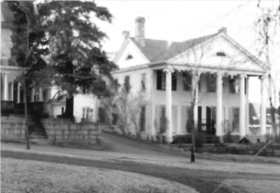

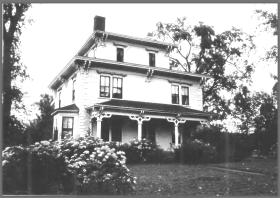
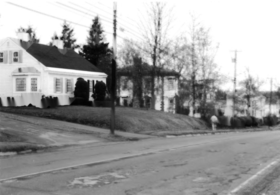

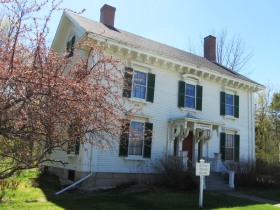
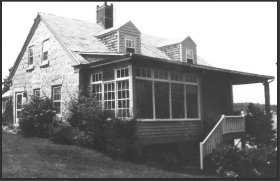
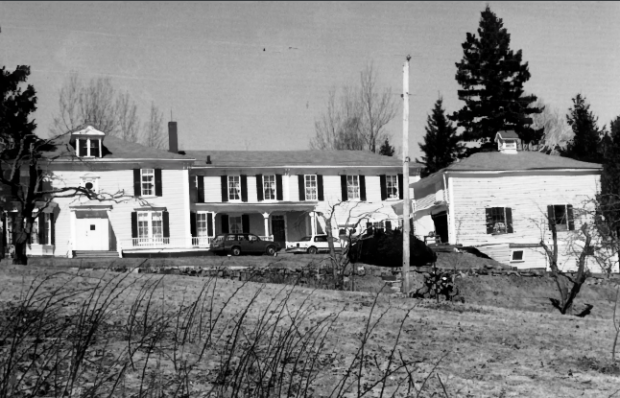
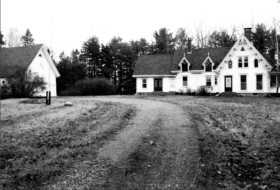
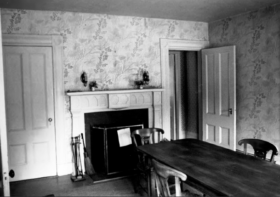

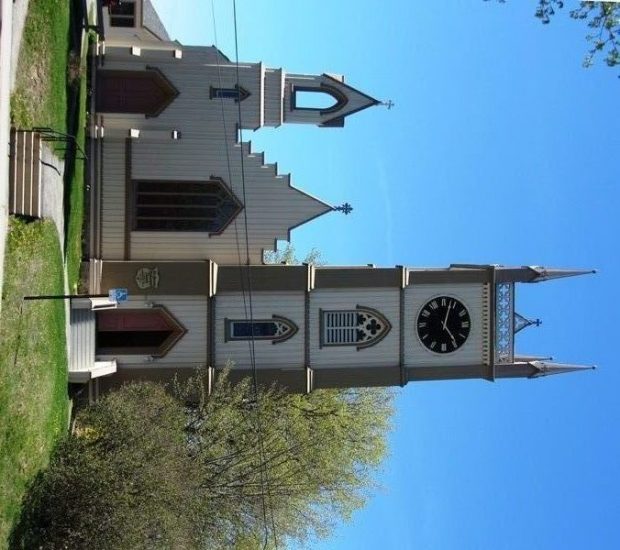

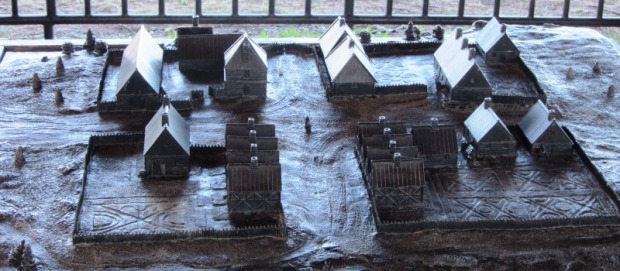


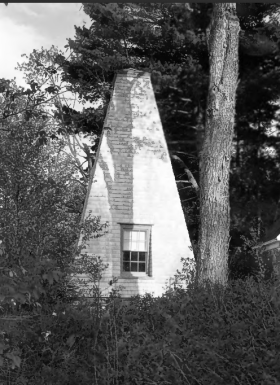
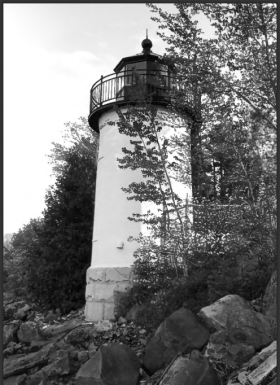
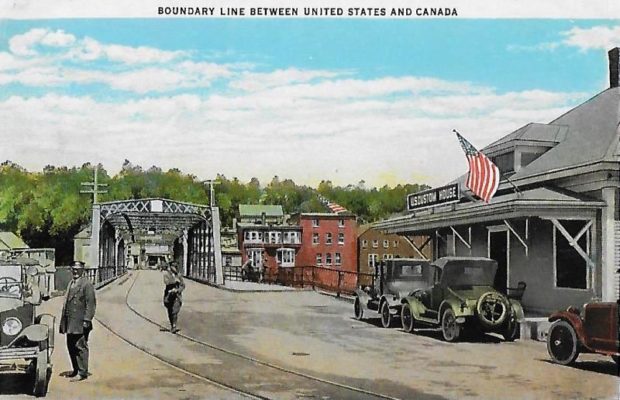
Have just returned from a visit to Calais where 3 generations of my mother’s family came beginning in the 1830’s and the last passing away. in 1958. The best part of the visit was meeting staff of the St. Croix Historical Society and seeing the fabulous job that has been
done to restore the Dr. Job Holmes House on Main St. My great-great grandfather Asher
Benjamin Bassford was the architect and builder of that house as well as five other homes
in Calais. It was however, sad to see the family homes on Temperance St. and on the corner of Main and Elm had been demolished. We found St. Croix Island a beautiful and interesting
place.